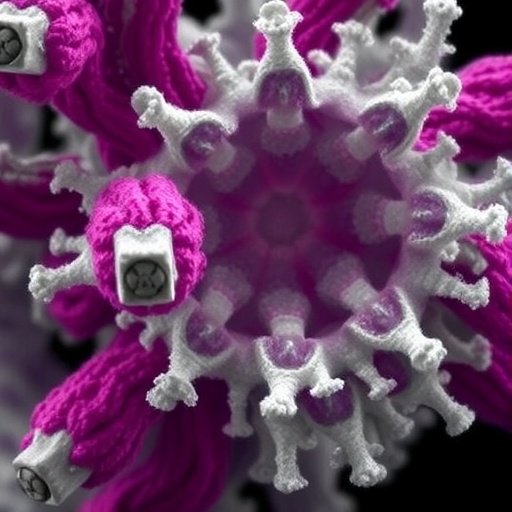In a groundbreaking study set to reshape our understanding of ribosome biogenesis, researchers have unraveled the intricate molecular choreography underlying the maturation and disassembly of the small subunit (SSU) processome within the nucleolus. This complex journey, crucial for the biogenesis of ribosomes and fundamental to cellular life, is revealed here through the lens of RNA helicases and their orchestrated activities on pre-ribosomal RNA substrates.
Nuclear bodies such as the nucleolus, Cajal bodies, and nuclear speckles, known for their condensate properties, serve as dynamic hubs for RNA synthesis and processing. Despite their seemingly amorphous appearance, these organelles follow unified organizational principles predicated on multivalent interactions. Central to this paradigm is the SSU processome, a large RNA-protein complex that matures into the small ribosomal subunit. However, molecular details defining its maturation sequence have remained elusive—until now.
The study highlights the pivotal roles of two RNA helicases—Mtr4, an essential component linked to RNA degradation machinery, and Dhr1, intrinsic to the SSU processome itself. These enzymes drive a finely tuned sequence of events, wherein irreversible unwinding and degradation of a critical RNA segment, the 5′ external transcribed spacer (ETS), dynamically alter SSU processome composition. This transformation enables specific regulatory peptides, notably those associated with Utp14, to detect and respond to these compositional changes, ultimately activating Dhr1 to catalyze the critical removal of U3 small nucleolar RNA (snoRNA).
Strikingly, the mechanism hinges on multivalent tethering at three hierarchical levels. At the intraparticle level, tethering within the SSU processome scaffolds pre-recruitment of necessary assembly factors, crucial for restructuring the processome and facilitating A1 cleavage—one of the essential processing steps. At a higher organizational tier, the tethering between large complexes, such as the RNA exosome and the SSU processome, modulates as the exosome matures and initiates SSU processome disassembly. This maturation effectively transitions the exosome’s role from initial RNA substrate recognition to active engagement and surveillance.
On an even broader spatial scale within the nucleolus, tethering of the SSU processome to the organelle itself diminishes progressively. This decline corresponds with the release of nucleolar assembly factors and reflects a reduction in multivalent interactions before the pre-ribosomal particles exit the nucleolus. This insight challenges previous assumptions that nonspecific interaction loss triggers particle release; instead, it is the selective disengagement of specific protein-protein and protein-RNA interactions that orchestrates this critical step.
The unraveling of the SSU processome’s maturation and disassembly pathway comes with meticulously detailed transitions captured at an atomic scale. These molecular revelations provide a mechanistic framework linking nanoscale biochemical events with the mesoscale organization of fibrillar nucleolar compartments observed in microscopy studies. Such understanding bridges a vital gap in structural biology and cellular biophysics, delivering unprecedented clarity to how RNA helicases coordinate dynamic RNA-protein assemblies.
Beyond revealing component-level dynamics, the study underscores the imperative coordination between RNA degradation and remodeling machinery. Mtr4 helicase and the RNA exosome act not merely as degradative agents but as regulatory gatekeepers that influence ribonucleoprotein composition, facilitating a seamless progression through maturation states. In parallel, Dhr1 helicase operates intimately within the SSU processome, engineered to execute a terminal, irreversible function—liberating critical snoRNA elements to conclude particle assembly stages.
A particularly transformative aspect of this work is highlighting the concept of valency—a quantitative measure of the number of tethering interactions—as a functional parameter governing the stability and progression of RNA-protein assemblies. Decreased valency simplifies these complexes, effectively priming them for nucleolar release, illustrating a powerful principle of biological self-organization and quality control within nuclear compartments.
Importantly, the findings have wide-reaching implications for our understanding of nuclear body dynamics beyond ribosome biogenesis. They suggest a paradigm wherein RNA helicase-driven remodeling propels substantial reconfiguration and mobility of ribonucleoprotein particles through biomolecular condensates, effectively linking enzymatic activity to spatial organization and intracellular trafficking pathways.
The methodological rigor employed encompasses cutting-edge structural and temporal resolution techniques, enabling the dissection of fast and complex assembly/disassembly processes hitherto inaccessible. The resulting spatiotemporal model of SSU processome dynamics not only delineates the sequential order of molecular events but also captures transient intermediate states critical for fidelity and regulation.
With ribosome production intimately tied to cell growth, proliferation, and disease states such as cancer, understanding these molecular underpinnings opens avenues for therapeutic targeting of dysregulated ribosome biogenesis pathways. The nuanced elucidation of helicase-mediated processes presents potential molecular targets to modulate ribosome assembly in pathological contexts.
In summary, this pioneering investigation charts a detailed landscape of the SSU processome’s life cycle within the nucleolus, unveiling helicase-mediated mechanisms that choreograph maturation and release. By integrating molecular detail with organizational principles across scales, it delivers a synthetic view poised to accelerate research in RNA biology, nuclear architecture, and the fundamental biology of protein synthesis.
Article References:
Buzovetsky, O., Klinge, S. Helicase-mediated mechanism of SSU processome maturation and disassembly. Nature (2025). https://doi.org/10.1038/s41586-025-09688-3




